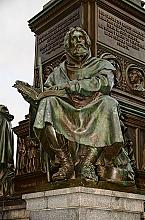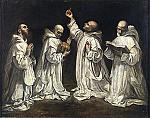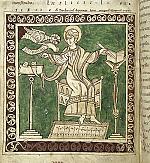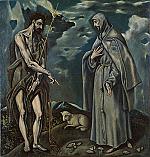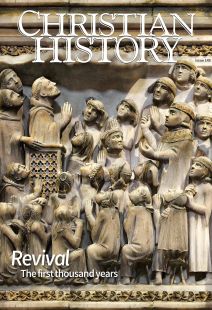Looking for the last emperor
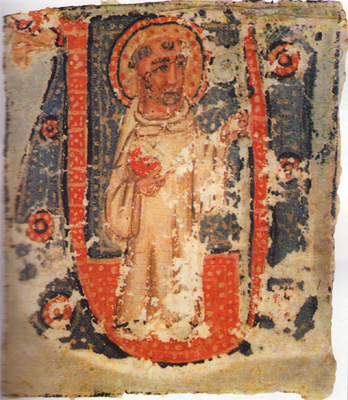
[Gioacchino da Fiore, miniatura sec. XIV, Codice Chigiano, Biblioteca Apostolica Vaticana, Roma—Beppeveltri / public domain Wikimedia File:Gioacchino da Fiore, miniatura sec. XIV, Codice Chigiano, Biblioteca Apostolica Vaticana, Roma.jpg]
“Repent, because the kingdom of heaven has come near.” (Matt. 4:17)
In the tumult and uncertainty of world events, medieval Christians wondered if they walked in the last days and looked for the Antichrist around every corner. Often this tumult led to a search for spiritual change.
Surrender at Golgotha
Around 950 a monk named Adso wrote the most complete treatise on the Antichrist to date. The Antichrist would come from the Jewish tribe of Dan, he argued, and would be raised in the East. Before he could come, however, a Frankish king must reign. This king would triumph over all the enemies of Christendom and rule a peaceful, Christian world. He would then go to Golgotha to surrender his crown, and this would signal the coming of the Antichrist.
Adso’s notion of this “Last World Emperor” spread like wildfire. Perhaps reform would come through a strong leader, people thought. The Chanson de Roland, written about 1095, depicts Charlemagne as a messianic ruler triumphing over all Muslims and pagans. Count Emich of Leisingen, a leader of the First Crusade, massacred Jews who refused to convert because he was convinced God had summoned him to be the Last World Emperor. At the same time, tensions between national and church rulers were waxing. Kings and emperors used Adso’s messianism in their defense.
Church corruption (greed, sexual license, and power grabbing) and the inability of ecclesiastical leaders to reform the church fueled the popular expectation of impending doom. As a result people like German abbess Hildegard of Bingen (1098–1179) predicted that lay princes would forcibly take away land and riches clergy had amassed, but Christendom would enter an era of millennial prosperity and peace. Then disarmament would entice pagans to attack Christian nations. She believed Christians would win for a time, but ultimately the Holy Roman Emperor and the pope would lose most of their power in preparation for the coming of the Antichrist. The influence of Hildegard’s visions was not limited to her convent—the pope approved her visions, and she corresponded with many church leaders and went on four preaching tours, speaking out against corruption and calling for revival and renewal.
Is the west Babylon?
One of the more well-known apocalyptic proponents of church reform, Abbot Joachim of Fiore (c. 1135–1202), constructed two schemes for understanding the past and the future. One divided history into two times, that of the Jews and that of the Gentiles, culminating after 1200. The other scheme divided history into three states, paralleling the Trinity and the three orders (laity, clergy, and monks).
Joachim compared Christendom to Babylon because, he said, everyone wanted money, power, and worldly fame. Shortly after 1200, he speculated, two anti-Christian forces, possibly Muslims and heretics, would attack, defeat, and severely persecute Christians. Thus purified, a reforming pope and monastic orders would create a holier world in which people would attain unsurpassed understanding of the hidden meaning of the Scriptures. For an indeterminate period, Christians would dominate the world in peace.
Little surprise, then, that rivalry between popes and emperors did culminate in the 1240s when Pope Innocent IV waged “total war”—a war of both swords and words—against Emperor Frederick II. Frederick’s supporters hailed him as a messiah, a wonder of the world (stupor mundi). But Innocent and his supporters branded Frederick the Antichrist. Even after the Holy Roman Emperor died in 1250, at least one Innocent supporter refused to believe it—the emperor had not accomplished all the evil expected of him as the Antichrist. This conflict reverberated in apocalyptic texts well into the 1300s.
New beginning or final end?
Further church reform continued to prove elusive. Even the Franciscan and Dominican orders, founded as reform movements (see pp. 28–32), were caught up in amassing wealth. Pope Boniface VIII (c. 1234–1303), a canon lawyer, combined rampant nepotism with extreme claims for papal power. French pope Clement V (1264–1314) moved the papal court to Avignon, which upset everybody but the French, who dominated the papacy for the next 70 years.
A spate of texts interpreted these and other events apocalyptically. Benedictine monk Henry of Kirkstede, a librarian who collected prophetic texts from Hildegard, Joachim, and others, was perplexed. Authorities gave radically different meanings to the same events. The bubonic plague had swept across Europe between 1346 and 1353, killing perhaps 40 percent of the population. The Great Schism in 1378 had divided the church between popes in Avignon and Rome. Henry wondered if such events portended the coming of the Antichrist and the end of history, or the beginning of true church reform.
In either case eschatological enthusiasm spilled over into great literature of the day. Virgil tells Dante (c. 1265–1321) in the first canto of the Divine Comedy that no one could ascend the hill past the “beast” until a hound came “who would eat wisdom, love, and virtue, not land and money.” William Langland (c. 1332–c. 1386), the author of Piers Plowman, envisioned a new David, whose reign would be marked by total peace, honesty, and justice. All weapons would be forcibly destroyed, and non-Christians would stand in awe of Christian goodness.
Scarcely a ruler ascended a throne without someone calling him a messiah. If English, he would seize the sword Excalibur and be a new Arthur. French kings would be Charlemagnes. German ones were all Fredericks. But though the kings of England and France took control of the church, none reformed it as expected. Disappointment led to apocalyptic visions against these rulers.
Jean de Roquetaillade (c. 1310–c. 1370), a pro-French Franciscan, wrote from prison that a true millennium would begin about 1370, when “popular justice” would overturn the corrupt social order. Itinerant English cleric John Ball (c. 1338–1381) preached Edenic equity and prophesied that God was ready to overthrow inequality and private property: “When Adam delved [dug] and Eve span, who was then the gentleman?,” he wrote. Peasants who joined Ball in the Peasants’ Revolt of 1381 were responding to such millennial dreams.
In another corner of Europe, the burning of Czech reformer Jan Hus (1369–1415) led to widespread and apocalyptic rebellion (pp. 21–25). The most radical Hussites, called Taborites, seized a mountain and tried to start a revolution in which both worldly ranks and private property would be abolished. Moderate Hussites eventually repressed the radicals, but similar rebels would appear in Germany in 1525 and radical millennialists would take over Münster in the 1530s (see p. 45).
Hope for Adso’s “Last World Emperor” continued into the Reformation era (pp. 44–47). In 1494 French king Charles VIII led an army into Italy. His appearance at Florence smashed the citizens’ apocalyptic illusions that they were a match for the powerful kingdoms of the north. Dominican friar Girolamo Savonarola (p. 25) stepped into the spotlight, preached powerful sermons against wealth and luxuries, and predicted that the French army was only a prelude to the coming of a holy, pure, millennial world. Charles just might be the true Last World Emperor, he thought. When Charles was defeated, Savonarola was burned at the stake.
In the 1500s apocalypticism was still ubiquitous. University scholars eagerly collected new prophecies and commented anew on older ones. Churchmen dreamed of long-awaited clerical reform, and it arrived with a vengeance. Townspeople and peasants sought social justice through millennial movements. Only in the seventeenth and eighteenth centuries, with the rise of the Enlightenment, did church authorities, both Protestant and Catholic, push underground the apocalyptic enthusiasm that had so characterized European Christianity for seven centuries. But, as the events of future centuries and on other continents would show, concern for the last days—and the spur to reform that this concern sometimes birthed—would not stay underground for long. CH
By Randolph Daniel
[Christian History originally published this article in Christian History Issue #149 in 2023]
Randolph Daniel was emeritus professor of history at the University of Kentucky and author of The Franciscan Concept of Mission in the High Middle Ages and Abbott Joachim of Fiore and Joachimism. This article is adapted slightly from one that originally appeared in CH #61.Next articles
Poor in spirit, new in Christ
While they looked for renewal, the Waldensians looked like trouble
Alan KreiderPraying and preaching for a better church and society
Revival and renewal took many different forms in the High and late Middle Ages
Jennifer BoardmanChristian History Timeline: Reform, renewal, revival, reaction
Both clergy and laity sought a renewal of devotion and an end to corruption throughout the Middle Ages —but it was sometimes a bumpy road
the editors“Repair my house”
Francis of Assisi and his followers called the church back to holiness through vibrant preaching and voluntary poverty
Jon M. SweeneySupport us
Christian History Institute (CHI) is a non-profit Pennsylvania corporation founded in 1982. Your donations support the continuation of this ministry
Donate



